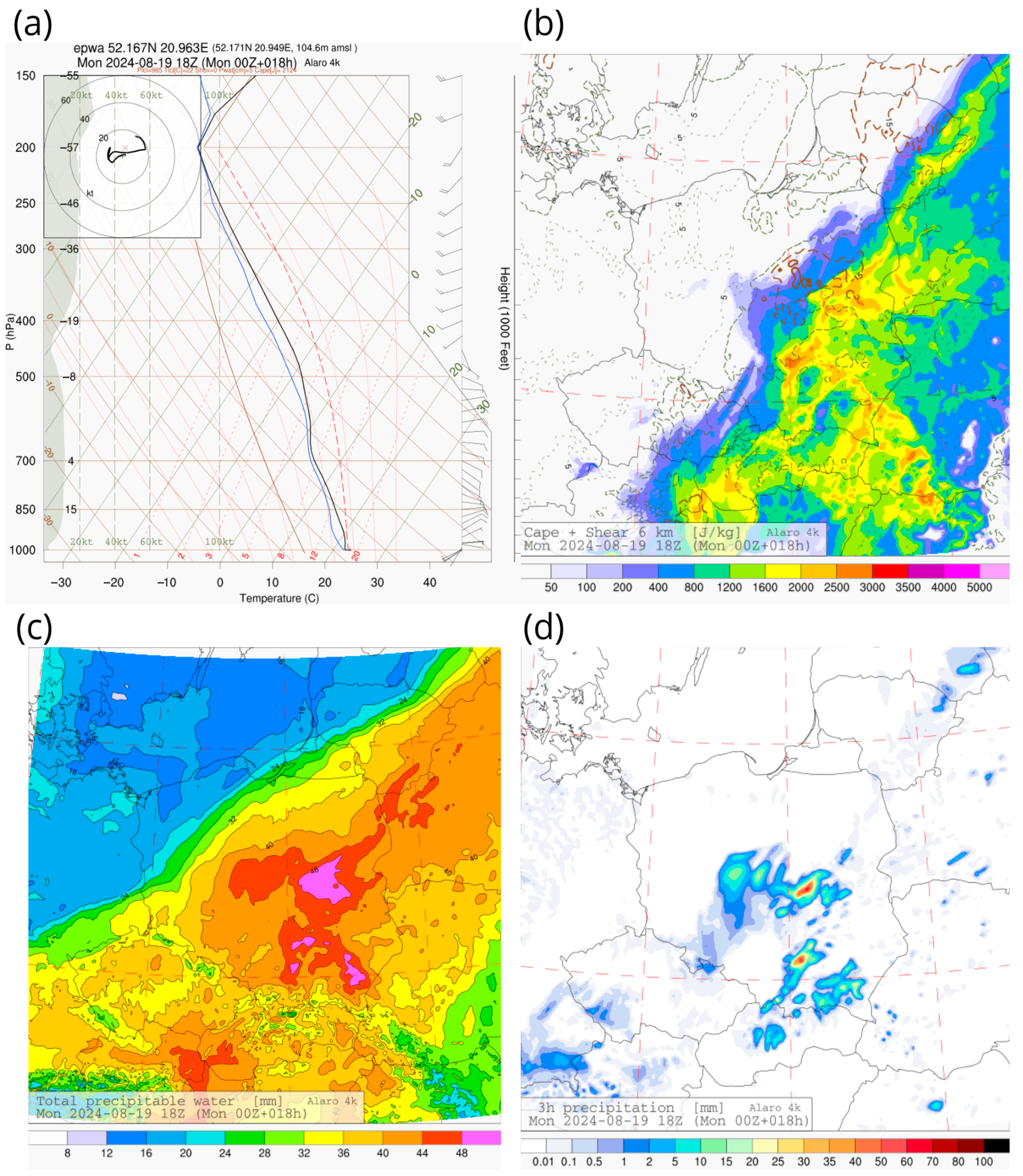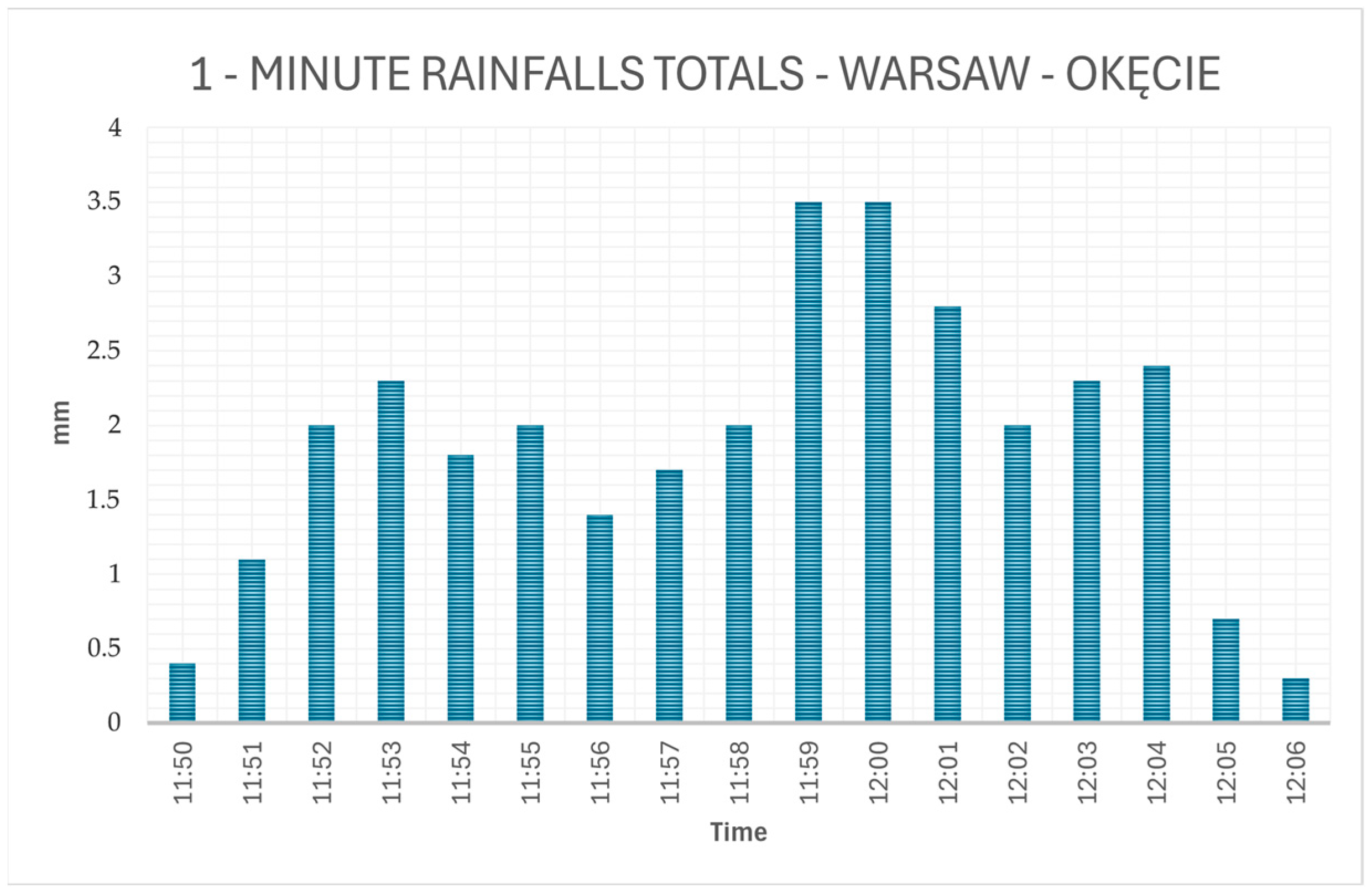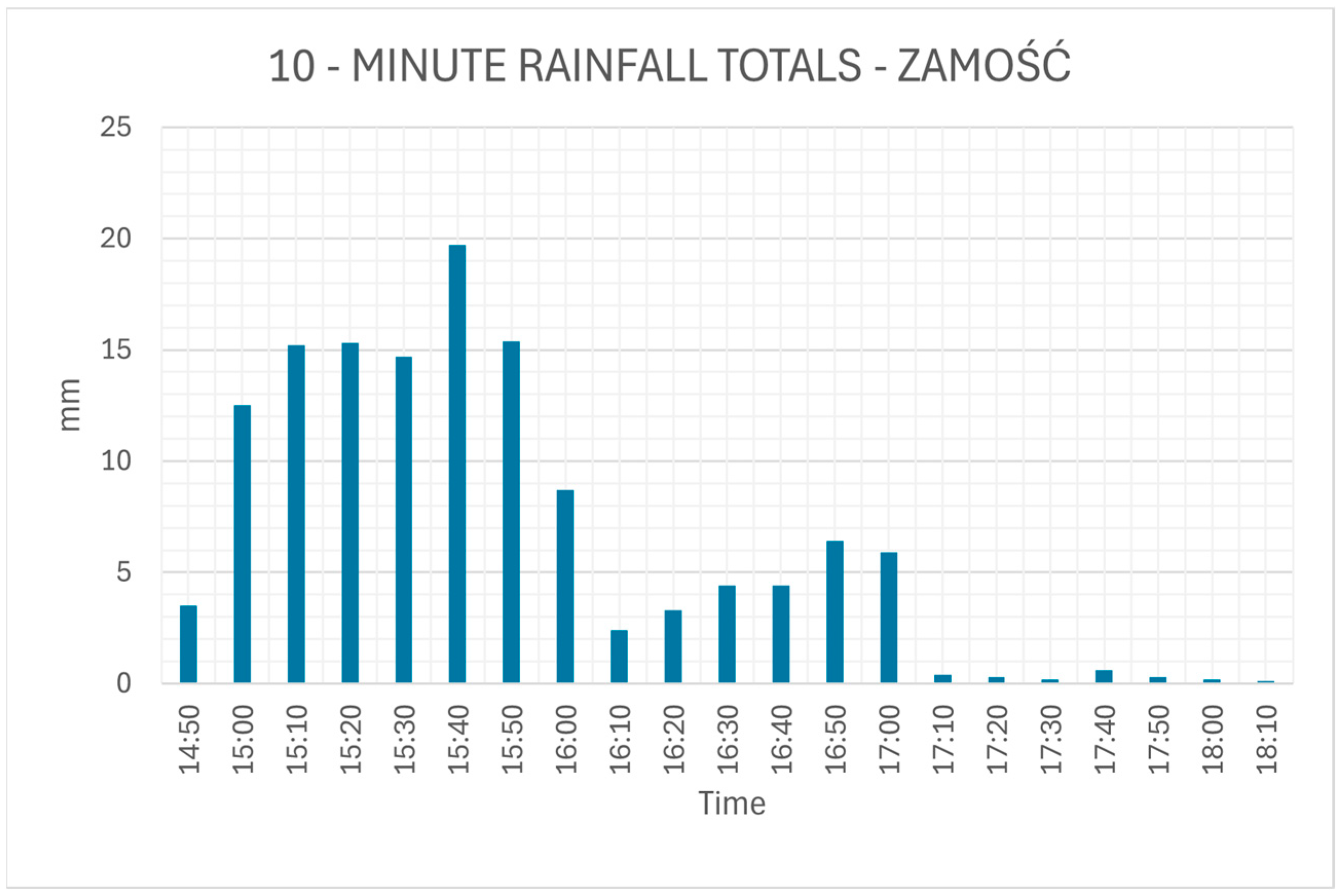Extreme Short-Duration Rainfall and Urban Flood Hazard: Case Studies of Convective Events in Warsaw and Zamość, Poland
Abstract
1. Introduction
2. Materials and Methods
2.1. Data Sources
2.2. Rainfall Classification
- Measurement of precipitation using instruments such as rain gauges or pluviographs.
- Determination of event duration in minutes.
- Application of the formula to obtain the efficiency index.
2.3. Radar and Numerical Model Analysis
3. Results
3.1. Synoptic and Thermodynamic Conditions—Warsaw (19 August 2024)
3.2. Precipitation Intensity and Radar Diagnostics—Warsaw (19 August 2024)
3.3. Synoptic and Thermodynamic Conditions—Zamość (21 August 2024)
3.4. Precipitation Intensity and Radar Diagnostics—Zamość (21 August 2024)
4. Convective System Structure and Organization
4.1. Convective System Typology
4.2. The 19 August Multicellular Linear Convective System: Structure and Dynamics
4.3. The 21 August Back-Building Training System: Structure and Dynamics
5. Discussion
- Germany/Belgium, July 2021: A quasi-stationary low-pressure system produced 100–150 mm of rain over 24–48 h, leading to catastrophic flooding in the Ahr Valley. The event was marked by blocked upper-level flow and orographic enhancement—features echoed in the Zamość setup [38].
- Central Europe, August 2002: Successive Vb-type cyclones originating from the Mediterranean generated over 300–400 mm of rain across southern Bohemia and Austria within several days. These events highlighted the vulnerability of mountain catchments to persistent mesoscale rainfall [39].
- Southern France, September 2002: A quasi-stationary mesoscale convective system dropped more than 600 mm of rainfall within 24 h in the Gard region. Despite its Mediterranean character, the storm’s morphology—especially training convection—bears similarity to the Zamość event [40].
- Southeastern Spain, September 2019 (DANA): A cut-off upper-level low interacting with moist Mediterranean inflow caused over 500 mm of rain in two days. Although thermodynamically distinct, it shares synoptic traits with the August 2024 setup over eastern Poland [41].
6. Conclusions
- Both events qualify as torrential rainfall episodes according to the Chomicz α index, with the Zamość case reaching α = 12.8—classifying it as a third-degree event and among the highest recorded in operational archives.
- The Zamość storm represents one of the most extreme short-duration rainfall events in the region, producing 88.3 mm within one hour, 131.3 mm over a 3 h period, and 147.2 mm during the entire precipitation day, with negligible horizontal storm motion.
- Highly urbanized areas with limited infiltration capacity—such as Warsaw and Zamość—are particularly vulnerable to flash flooding from short-lived but intense convective systems.
- There is an urgent need to modernize urban drainage infrastructure, incorporate high-resolution hydrometeorological data into planning frameworks, and adapt to the increasing frequency of convective extremes under climate change.
- The results highlight the importance of dynamic and spatially precise early warning systems, particularly those incorporating real-time radar monitoring and nowcasting capabilities to identify slow-moving or repeatedly regenerating convective cells with high precipitation efficiency.
- Further studies should explore urban runoff modeling under convective rainfall scenarios, develop improved rainfall–risk indices tailored to urban surfaces, and test nowcasting integration into local flood warning systems. These directions can enhance resilience to short-duration hydrometeorological extremes.
Author Contributions
Funding
Data Availability Statement
Acknowledgments
Conflicts of Interest
Abbreviations
| MCS | Mesoscale Convective System |
| MCC | Mesoscale Convective Complex |
| CAPE | Convective Available Potential Energy |
| TPW/PWAT | Total Precipitable Water / Precipitable Water |
| UTC | Coordinated Universal Time |
| RDT | Rapidly Developing Thunderstorms (satellite product) |
| MSG | Meteosat Second Generation |
| IMGW-PIB | Institute of Meteorology and Water Management—National Research Institute |
| FFGS | Flash Flood Guidance System |
| WMO | World Meteorological Organization |
| ALARO | AROME Limited Area Model with Optional Radiation |
| POLRAD | Polish national radar network |
| EPWA | ICAO code for Warsaw-Okęcie Airport |
| α index | Rainfall efficiency index by Chomicz |
| B1, B2, B3… | Symbolic codes for torrential rainfall severity based on α index |
References
- Trenberth, K.E. Changes in precipitation with climate change. Clim. Res. 2011, 47, 123–138. [Google Scholar] [CrossRef]
- IPCC. Climate Change 2021: The Physical Science Basis; Cambridge University Press: Cambridge, UK, 2021. [Google Scholar]
- Choryński, A.; Pińskwar, I.; Graczyk, D.; Kundzewicz, Z.W. Observed changes in extreme precipitation in Poland: 1991–2015 versus 1961–1990. Theor. Appl. Climatol. 2019, 135, 1245–1261. [Google Scholar] [CrossRef]
- Kalbarczyk, R.; Kalbarczyk, E. Risk of Natural Hazards Caused by Extreme Precipitation in Poland in 1951–2020. Water 2024, 16, 1705. [Google Scholar] [CrossRef]
- Varlas, G.; Anagnostou, M.N.; Spyrou, C.; Papadopoulos, A.; Kalogiros, J.; Mentzafou, A.; Michaelides, S.; Baltas, E.; Karymbalis, E.; Katsafados, P. A Multi-Platform Hydrometeorological Analysis of the Flash Flood Event of 15 November 2017 in Attica, Greece. Remote Sens. 2019, 11, 45. [Google Scholar] [CrossRef]
- Costa, S.B.; Herdies, D.L.; Souza, D.O. Extreme Precipitation Events on the East Coast of Brazil’s Northeast: Numerical and Diagnostic Analysis. Water 2021, 14, 3135. [Google Scholar] [CrossRef]
- Allan, R.P.; Soden, B.J.; John, V.O.; Ingram, W.; Good, P. Current changes in tropical precipitation. Environ. Res. Lett. 2010, 5, 025205. [Google Scholar] [CrossRef]
- Wypych, A.; Ustrnul, Z.; Czekierda, D.; Palarz, A. Extreme Precipitation Events in the Polish Carpathians and Their Synoptic Determinants. Időjárás 2018, 122, 161–184. [Google Scholar] [CrossRef]
- Kundzewicz, Z.W.; Krysanova, V.; Dankers, R.; Hirabayashi, Y.; Kanae, S.; Hattermann, F.F.; Huang, S.; Milly, P.C.D.; Stoffel, M.; Driessen, P.P.J.; et al. Differences in flood hazard projections in Europe. Hydrol. Sci. J. 2017, 62, 1–14. [Google Scholar] [CrossRef]
- Nowosad, J.; Stach, A. Relation between extensive extreme precipitation in Poland and atmospheric circulation. Quaest. Geogr. 2014, 33, 115–129. [Google Scholar] [CrossRef]
- Pińskwar, I.; Choryński, A.; Graczyk, D. Flash floods in Poland’s Wielkopolska region. Int. J. Disaster Risk Sci. 2023, 14, 440–457. [Google Scholar] [CrossRef]
- Da Silva, N.; Haerter, J. The characteristics of mesoscale convective system rainfall over Europe. ESS Open Arch. 2023. [Google Scholar] [CrossRef]
- Górka, M.; Pilarz, A.; Modelska, M.; Drzeniecka-Osiadacz, A.; Potysz, A.; Widory, D. Urban Single Precipitation Events: A Key for Characterizing Sources of Air Contaminants and the Dynamics of Atmospheric Chemistry Exchanges. Water 2024, 16, 3701. [Google Scholar] [CrossRef]
- Banasik, K.; Hejduk, L.; Barszcz, M. Flood flow consequences of land use changes in a small urban catchment of Warsaw. In Proceedings of the 11th International Conference on Urban Drainage (ICUD), Edinburgh, UK, 31 August–5 September 2008. [Google Scholar]
- Banasik, K.; Krajewski, A.; Sikorska, A.; Hejduk, L. Curve number estimation for a small urban catchment from recorded rainfall-runoff events. Arch. Environ. Prot. 2014, 40, 75–86. [Google Scholar] [CrossRef]
- Kourtis, I.M.; Tsihrintzis, V.A. Adaptation of Urban Drainage Networks to Climate Change: A Review. Sci. Total Environ. 2021, 771, 145431. [Google Scholar] [CrossRef]
- Dzwonkowski, K.; Winnicki, I.; Pietrek, S.; Siewert, J. Analysis of Precipitation Totals Based on Radar and Rain Gauge Data. Remote Sens. 2025, 17, 2157. [Google Scholar] [CrossRef]
- Piniewski, M.; Szcześniak, M.; Kardel, I.; Chattopadhyay, S.; Berezowski, T. G2DC-PL+: Gridded daily climate data for Poland. Earth Syst. Sci. Data 2021, 13, 1273–1288. [Google Scholar] [CrossRef]
- Lenderink, G.; van Meijgaard, E. Increase in hourly precipitation extremes beyond expectations from temperature changes. Nat. Geosci. 2008, 1, 511–514. [Google Scholar] [CrossRef]
- Prein, A.F.; Rasmussen, R.M.; Ikeda, K.; Liu, C.; Clark, M.P.; Holland, G.J. Future intensification of hourly precipitation extremes. Nat. Clim. Change 2017, 7, 48–52. [Google Scholar] [CrossRef]
- Papalexiou, S.M.; Montanari, A. Global warming increases risk of extreme rainfall. Water Resour. Res. 2019, 55, 4496–4509. [Google Scholar] [CrossRef]
- Kendon, E.J.; Roberts, N.M.; Fowler, H.J.; Roberts, M.J.; Chan, S.C.; Senior, C.A. Heavier summer downpours with climate change. Nat. Clim. Change 2014, 4, 570–576. [Google Scholar] [CrossRef]
- Ghasemifard, H.; Groenemeijer, P.; Battaglioli, F.; Púčik, T. Do changing circulation types raise the frequency of summertime thunderstorms and large hail in Europe? Environ. Res. Clim. 2024, 3, 015006. [Google Scholar] [CrossRef]
- Asher, M.; Pedersen, J.W.; Boeing, S.; Birch, C.; Trigg, M.; Kendon, E. Extreme Rainfall and Temporal Loading in Great Britain: Analysis Using a Convection-Permitting Climate Model. SSRN Prepr. 2024. [Google Scholar] [CrossRef]
- Chomicz, K. Ulewy i deszcze nawalne w Polsce. Wiad. Służby Hydrol. Meteorol. 1951, 2, 5–88. [Google Scholar]
- WMO. WMO Guidelines on Multi-Hazard Impact-Based Forecast and Warning Services; WMO-No. 1150; World Meteorological Organization: Geneva, Switzerland, 2019; Available online: https://library.wmo.int/index.php?lvl=notice_display&id=21704 (accessed on 2 July 2025).
- WMO. Flash Flood Guidance System: Reference Guide; WMO-No. 1099; World Meteorological Organization: Geneva, Switzerland, 2013. [Google Scholar]
- Doswell, C.A., III. Severe convective storms—An overview. In Severe Convective Storms; Doswell, C.A., III, Ed.; American Meteorological Society: Boston, MA, USA, 2001; Volume 28, pp. 1–26. [Google Scholar] [CrossRef]
- Surowiecki, A.; Taszarek, M. A 10-Year Radar-Based Climatology of Mesoscale Convective System Archetypes and Derechos in Poland. Mon. Weather Rev. 2020, 148, 3253–3273. [Google Scholar] [CrossRef]
- Maddox, R.A. Mesoscale Convective Complexes. Bull. Am. Meteorol. Soc. 1980, 61, 1374–1387. [Google Scholar] [CrossRef]
- Houze, R.A. Mesoscale Convective Systems. Rev. Geophys. 2004, 42, RG4003. [Google Scholar] [CrossRef]
- Loglisci, N.; Boni, G.; Cauteruccio, A.; Faccini, F.; Milelli, M.; Paliaga, G.; Parodi, A. The role of citizen science in assessing the spatiotemporal pattern of rainfall events in urban areas: A case study in the city of Genoa, Italy. Nat. Hazards Earth Syst. Sci. 2024, 24, 2495–2510. [Google Scholar] [CrossRef]
- Esbrí, L.; Rigo, T.; Llasat, M.; Aznar, B. Identifying Storm Hotspots and the Most Unsettled Areas in Barcelona by Analysing Significant Rainfall Episodes from 2013 to 2018. Water 2021, 13, 1730. [Google Scholar] [CrossRef]
- Chen, Y.; Zhang, S.; Wang, H.; Chen, D.; Liu, J. Human-Induced Climate Change Intensifies Extreme Precipitation Events in Central China’s Urban Areas. Geophys. Res. Lett. 2025, 51, e2024GL111818. [Google Scholar] [CrossRef]
- Pilguj, N.; Surowiecki, A.; Szuster, P.; Duniec, G.; Figurski, M. Opady Nawalne w Zamościu i Okolicach (21.08.2024). IMGW-PIB, Centrum Modelowania Meteorologicznego. 2024. Available online: https://modele.imgw.pl/?p=42513 (accessed on 7 July 2025).
- Torelló-Sentelles, H.; Marra, F.; Koukoula, M.; Villarini, G.; Peleg, N. Intensification and Changing Spatial Extent of Heavy Rainfall in Urban Areas. Earth’s Future 2024, 12, e2024EF004505. [Google Scholar] [CrossRef]
- Łupikasza, E. Spatial and temporal variability of extreme precipitation in Poland in the period 1951–2006. Int. J. Climatol. 2010, 30, 991–1007. [Google Scholar] [CrossRef]
- Lehmkuhl, F.; Schüttrumpf, H.; Schwarzbauer, J.; Brüll, C.; Dietze, M.; Letmathe, P.; Völker, C.; Hollert, H. Assessment of the 2021 summer flood in Central Europe. Environ. Sci. Eur. 2022, 34, 107. [Google Scholar] [CrossRef]
- Ulbrich, U.; Brücher, T.; Fink, A.H.; Leckebusch, G.C.; Krüger, A.; Pinto, J.G. The Central European floods of August 2002. Weather 2003, 58, 371–377. [Google Scholar] [CrossRef]
- Delrieu, G.; Nicol, J.; Yates, E.; Kirstetter, P.E.; Creutin, J.D.; Anquetin, S.; Obled, C. The catastrophic flash-flood event of 8–9 September 2002 in the Gard region, France. J. Hydrometeorol. 2005, 6, 34–52. [Google Scholar] [CrossRef]
- Amengual, A. Hydrometeorological analysis of the 12 and 13 September 2019 widespread flash flooding in eastern Spain. Nat. Hazards Earth Syst. Sci. 2022, 22, 1159–1179. [Google Scholar] [CrossRef]












| Datasets | Source | Spatial Resolution | Notes |
|---|---|---|---|
| Rain gauge data | IMGW-PIB | Point (station) | Okęcie, Zamość |
| Radar data (POLRAD) | IMGW-PIB | 1 km | CMAX product |
| Satellite imagery | EUMETSAT | ~1–5 km | IR channels |
| Alaro model | IMGW_PIB | 4 km | 60 vertical levels |
| Rainfall Efficiency Index (α) | Rain Type and Severity Classification | Letter Code | |
|---|---|---|---|
| 4.01–5.65 | heavy rainfall | IV | A4 |
| 5.66–8.00 | torrential precipitation | V | B1 |
| 8.01–11.30 | torrential precipitation | VI | B2 |
| 11.31–16.00 | torrential precipitation | VII | B3 |
| 16.01–22.61 | torrential precipitation | VIII | B4 |
| 22.62–32.00 | torrential precipitation | IX | B5 |
| 32.01–45.23 | torrential precipitation | X | B6 |
| Parameter | Warsaw 19 August 2024 | Zamość 21 August 2024 |
|---|---|---|
| Total even duration | 17 min (main core) | 73 min (intense phase) |
| Max 1 min rainfall rate | 3.5 mm/min | >2.5 mm/min |
| Peak interval total | 32 mm in 17 min | 105.1 in 73 min |
| α-index (peak interval) | 8.2 | 12.3 |
| Chomicz classification | B2 (2nd-degree torrential) | B3 (3rd—degree torrential) |
| Convective organization | Multicellular, Linear | Back Building Training System |
Disclaimer/Publisher’s Note: The statements, opinions and data contained in all publications are solely those of the individual author(s) and contributor(s) and not of MDPI and/or the editor(s). MDPI and/or the editor(s) disclaim responsibility for any injury to people or property resulting from any ideas, methods, instructions or products referred to in the content. |
© 2025 by the authors. Licensee MDPI, Basel, Switzerland. This article is an open access article distributed under the terms and conditions of the Creative Commons Attribution (CC BY) license (https://creativecommons.org/licenses/by/4.0/).
Share and Cite
Pietras, B.; Pyrc, R. Extreme Short-Duration Rainfall and Urban Flood Hazard: Case Studies of Convective Events in Warsaw and Zamość, Poland. Water 2025, 17, 2671. https://doi.org/10.3390/w17182671
Pietras B, Pyrc R. Extreme Short-Duration Rainfall and Urban Flood Hazard: Case Studies of Convective Events in Warsaw and Zamość, Poland. Water. 2025; 17(18):2671. https://doi.org/10.3390/w17182671
Chicago/Turabian StylePietras, Bartłomiej, and Robert Pyrc. 2025. "Extreme Short-Duration Rainfall and Urban Flood Hazard: Case Studies of Convective Events in Warsaw and Zamość, Poland" Water 17, no. 18: 2671. https://doi.org/10.3390/w17182671
APA StylePietras, B., & Pyrc, R. (2025). Extreme Short-Duration Rainfall and Urban Flood Hazard: Case Studies of Convective Events in Warsaw and Zamość, Poland. Water, 17(18), 2671. https://doi.org/10.3390/w17182671






